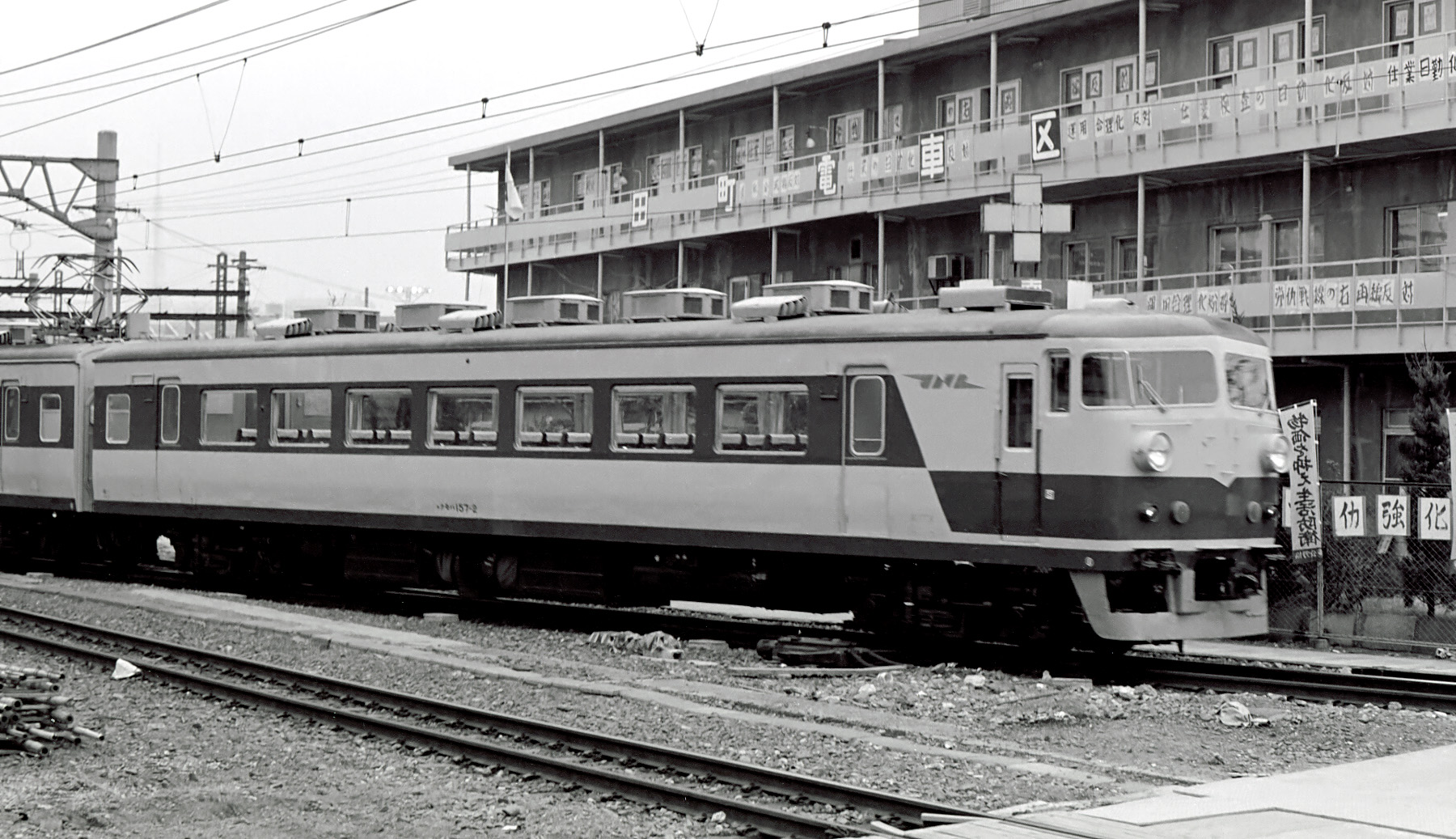157 Series on:
[Wikipedia]
[Google]
[Amazon]
The was a Japanese DC
File:157 Hibiki Yokohama.jpg, A 157 series set on a ''Hibiki'' limited express service in the 1970s
File:157 Shirane Ueno Station 19740811.jpg, A 157 series set on a ''Shirane'' limited express service from Ueno, August 1974
File:157series03tsc.jpg, The dedicated imperial train car KuRo 157-1, June 1977
File:183royal.JPG, The imperial train car KuRo 157-1 sandwiched in a 183 series set, August 1980


electric multiple unit
An electric multiple unit or EMU is a multiple-unit train consisting of self-propelled carriages using electricity as the motive power. An EMU requires no separate locomotive, as electric traction motors are incorporated within one or a numbe ...
(EMU) train type operated on limited express
A limited express is a type of express train service. It refers to an express service that stops at a limited number of stops in comparison to other express services on the same or similar routes.
Japan
The term "limited express" is a common ...
services by Japanese National Railways
The abbreviated JNR or , was the business entity that operated Japan's national railway network from 1949 to 1987.
Network Railways
As of June 1, 1949, the date of establishment of JNR, it operated of narrow gauge () railways in all 46 pref ...
(JNR) from 1959 until 1980.
Operations
The 157 series EMUs were first introduced by JNR on ''Nikkō
is a city located in Tochigi Prefecture, Japan. , the city had an estimated population of 80,239 in 36,531 households, and a population density of 55 persons per km2. The total area of the city is . It is a popular destination for Japanese and ...
'' semi express services between and on 22 September 1959 to counter competition from the private company Tobu Railway
is a Japanese commuter railway and ''keiretsu'' holding company in the Greater Tokyo Area as well as an intercity and regional operator in the Kantō region. Excluding the Japan Railways Group companies, Tobu's rail system is the second longes ...
, which also operated trains to Nikkō. They were also used on ''Chusenji'' services between and Nikkō, and ''Nasuno
The is a train service operated on the Tōhoku Shinkansen by East Japan Railway Company (JR East) in Japan. It serves all stations between and , a medium-sized city approximately 225 km north of Tokyo.JR Timetable, December 2008
Origin
...
'' services between and .
157 series EMUs were also introduced on seasonal ''Hibiki'' services on the Tokaido Main Line from 21 November 1959, and were later used on ''Amagi'' and '' Soyokaze'' services.
Fleet details
* KuMoHa 157-1 – 10: Driving motor cars * MoHa 156-1 – 10: Intermediate motor cars, with one pantograph * SaHa 157-1 – 5: Intermediate trailer cars * SaRo 157-1 – 6: Intermediate "Green" (first class) trailer cars * KuRo 157-1: Imperial train car (see below)External livery
Initially painted in the JNR livery of beige ("Cream No. 4") and crimson ("Red No. 11"), the red colour was later changed to a slightly darker shade ("Red No. 2") when the sets were modified with the addition of air-conditioning.KuRo 157-1 imperial train car
The 157 series fleet included a dedicatedimperial train
A royal train is a set of railway carriages dedicated for the use of the monarch or other members of a royal family. Most monarchies with a railway system employ a set of royal carriages.
Australia
The various government railway operators of A ...
car, built by Kawasaki Sharyo (present-day Kawasaki Heavy Industries
(or simply Kawasaki) is a Japanese Public company, public multinational corporation manufacturer of motorcycles, engines, Heavy equipment (construction), heavy equipment, aerospace and Military, defense equipment, rolling stock and ships, headq ...
) and delivered in June 1960. Numbered KuRo 157-1, the car could be inserted into 157 series formations for use on imperial train workings. One end had a gangwayed driving cab based on the 153 series EMU design, although the car was normally sandwiched in the middle of a 157 series formation, and was only very rarely used with the driving cab leading. In 1979, the car was modified for use in conjunction with 183 series EMUs, with the first official working on 2 July 1980. From March 1985, it was repainted in cream with a green stripe for use in conjunction with 185 series
Year 185 ( CLXXXV) was a common year starting on Friday (link will display the full calendar) of the Julian calendar. At the time, it was known as the Year of the Consulship of Lascivius and Atilius (or, less frequently, year 938 ''Ab urbe cond ...
EMUs.
The last official operation of the car was on 8 September 1993.
Following retirement, the KuRo 157-1 car remained in storage at Tamachi Depot for many years, but was moved to Tokyo General Rolling Stock Centre in the early hours of 2 December 2012.
History
The first 157 series set was delivered in August 1959, and entered service on ''Nikkō
is a city located in Tochigi Prefecture, Japan. , the city had an estimated population of 80,239 in 36,531 households, and a population density of 55 persons per km2. The total area of the city is . It is a popular destination for Japanese and ...
'' semi express services between Tokyo and Nikkō from 22 September 1959. Air-conditioning was added to the trains from 1962.
With the exception of the special imperial train car KuRo 157-1, the entire fleet of 157 series trains was withdrawn by 1980.
Fleet details
The individual car histories are as follows.References
{{JR East EMU Electric multiple units of Japan East Japan Railway Company Train-related introductions in 1959 1959 in rail transport